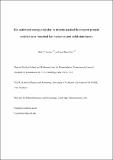Files in this item
Bio-optimized energy transfer in densely packed fluorescent protein enables near-maximal luminescence and solid-state lasers
Item metadata
| dc.contributor.author | Gather, Malte Christian | |
| dc.contributor.author | Yun, Seok Hyun | |
| dc.date.accessioned | 2015-06-07T23:10:54Z | |
| dc.date.available | 2015-06-07T23:10:54Z | |
| dc.date.issued | 2014-12-08 | |
| dc.identifier.citation | Gather , M C & Yun , S H 2014 , ' Bio-optimized energy transfer in densely packed fluorescent protein enables near-maximal luminescence and solid-state lasers ' , Nature Communications , vol. 5 , 5722 . https://doi.org/10.1038/ncomms6722 | en |
| dc.identifier.issn | 2041-1723 | |
| dc.identifier.other | PURE: 156677321 | |
| dc.identifier.other | PURE UUID: 1e124b7b-7dd1-498e-a04c-b1fed6530301 | |
| dc.identifier.other | Scopus: 84916907840 | |
| dc.identifier.other | ORCID: /0000-0002-4857-5562/work/47136475 | |
| dc.identifier.other | WOS: 000347229600005 | |
| dc.identifier.uri | https://hdl.handle.net/10023/6773 | |
| dc.description | This work was supported by the US National Science Foundation (ECCS- 1101947), National Institutes of Health (P41EB015903, R21EB013761), Department of Defense (FA9550-11-1-0331), and the Korea National Research Foundation (R31-2008-000-10071-0). M.C.G. acknowledges support from the Bullock-Wellman Fellowship, the Daimler and Benz Fellowship and the Marie Curie Career Integration Grant (PCIG12-GA-2012-334407). | en |
| dc.description.abstract | Bioluminescent organisms are likely to have an evolutionary drive towards high radiance. As such, bio-optimized materials derived from them hold great promise for photonic applications. Here, we show that biologically produced fluorescent proteins retain their high brightness even at the maximum density in solid state through a special molecular structure that provides optimal balance between high protein concentration and low resonance energy transfer self-quenching. Dried films of green fluorescent protein show low fluorescence quenching (−7 dB) and support strong optical amplification (gnet=22 cm−1; 96 dB cm−1). Using these properties, we demonstrate vertical cavity surface emitting micro-lasers with low threshold (<100 pJ, outperforming organic semiconductor lasers) and self-assembled all-protein ring lasers. Moreover, solid-state blends of different proteins support efficient Förster resonance energy transfer, with sensitivity to intermolecular distance thus allowing all-optical sensing. The design of fluorescent proteins may be exploited for bio-inspired solid-state luminescent molecules or nanoparticles. | |
| dc.format.extent | 8 | |
| dc.language.iso | eng | |
| dc.relation.ispartof | Nature Communications | en |
| dc.rights | © 2014. Macmillan Publishers Limited. All rights reserved. NPG Terms of reuse of archived manuscipts applies http://www.nature.com/authors/policies/license.html, The final version of record can be be found at: http://dx.doi.org/10.1038/ncomms6722 | en |
| dc.subject | QC Physics | en |
| dc.subject.lcc | QC | en |
| dc.title | Bio-optimized energy transfer in densely packed fluorescent protein enables near-maximal luminescence and solid-state lasers | en |
| dc.type | Journal article | en |
| dc.contributor.sponsor | European Commission | en |
| dc.description.version | Postprint | en |
| dc.contributor.institution | University of St Andrews. School of Physics and Astronomy | en |
| dc.contributor.institution | University of St Andrews. Biomedical Sciences Research Complex | en |
| dc.identifier.doi | https://doi.org/10.1038/ncomms6722 | |
| dc.description.status | Peer reviewed | en |
| dc.date.embargoedUntil | 2015-06-08 | |
| dc.identifier.url | http://www.nature.com/ncomms/2014/141208/ncomms6722/full/ncomms6722.html#supplementary-information | en |
| dc.identifier.grantnumber | PCIG12-GA-2012-334407 | en |
This item appears in the following Collection(s)
Items in the St Andrews Research Repository are protected by copyright, with all rights reserved, unless otherwise indicated.

